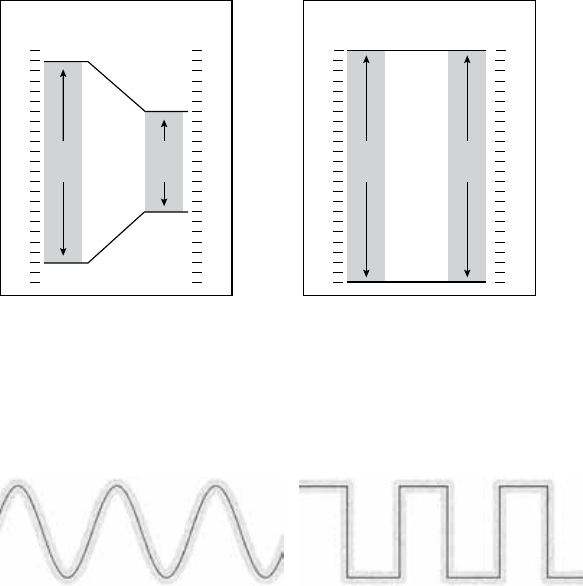
9
What makes a WiReless digital?
In a typical analog wireless microphone system the signal between the transmitter and the receiver
consists of a very high frequency radio wave carrier that is continually varied slightly in frequency by
the audio signal from the microphone (or other transducer). The electronic circuitry in the receiver
removes the carrier frequency and leaves the audio signal – the same principle that is used in FM radio
broadcasts. The signal is highly compressed upon transmission and expanded at the receiver – the origin
of the word “companding.” Analog transmissions are vulnerable to many interference effects from other
RF and electromagnetic signals – and the interference is usually audible as well as having the effect of
shortening range or rendering the channel unusable.
Input
Signal
(dBu)
+ 25
+ 20
+ 15
+ 10
+ 5
0
- 5
- 10
- 15
- 20
- 25
- 30
- 35
- 40
- 45
- 50
- 55
- 60
- 65
- 70
- 75
- 80
- 85
- 90
+ 25
+ 20
+ 15
+ 10
+ 5
0
- 5
- 10
- 15
- 20
- 25
- 30
- 35
- 40
- 45
- 50
- 55
- 60
- 65
- 70
- 75
- 80
- 85
- 90
Output
Signal
(dBu)
2:1 Compression Ratio
100dB
Dynamic
Range
50dB
Dynamic
Range
Input
Signal
(dBu)
+ 25
+ 20
+ 15
+ 10
+ 5
0
- 5
- 10
- 15
- 20
- 25
- 30
- 35
- 40
- 45
- 50
- 55
- 60
- 65
- 70
- 75
- 80
- 85
- 90
+ 25
+ 20
+ 15
+ 10
+ 5
0
- 5
- 10
- 15
- 20
- 25
- 30
- 35
- 40
- 45
- 50
- 55
- 60
- 65
- 70
- 75
- 80
- 85
- 90
Output
Signal
(dBu)
No Compression
115dB
Dynamic
Range
115dB
Dynamic
Range
Digital wireless microphone systems provide a much more robust and interference resistant performance.
Within the microphone transmitter, the audio signal from the voice or other source is digitally sampled,
and the sample is converted into a digital “word” consisting of the electrical equivalent of a string of
1’s and 0’s. As in analog wireless, a very high frequency carrier wave is modulated, but in this case with
the digital “stream” of samples so that the carrier frequency only has two distinct states that represent
the signal in the same manner that the flat areas and pits on a CD represent the music. The receiver
retrieves this information from the carrier and decodes it via a D/A converter and outputs an audio
signal that is the replica of what was encoded at the mic.
Analog signal with noise Digital signal with noise
Benefits of Digital Wireless
As mentioned above, analog wireless transmissions are susceptible to a variety of noise and interference
conditions, related to signal strength and/or interference from external electronic devices and other
wireless signals. These can ride along with the carrier frequency and its audio signal as added noise,
affect the receiver directly because the antennas that pick up the transmitter signal are also wide open
to pick up other radio signal in the same general RF band, or interact with the carrier frequency to create
additional harmonic frequencies. Problems can come from sources as diverse as a television broadcast
signal, other wireless mics in use, digital signal processors, or even malfunctioning fluorescent lighting
ballasts or other electrical devices.
While the same physics applies to a digital signal riding on a carrier wave, the digital signal with just two
states is more difficult to damage. If the receiver finds that something has come in that is not equivalent


















